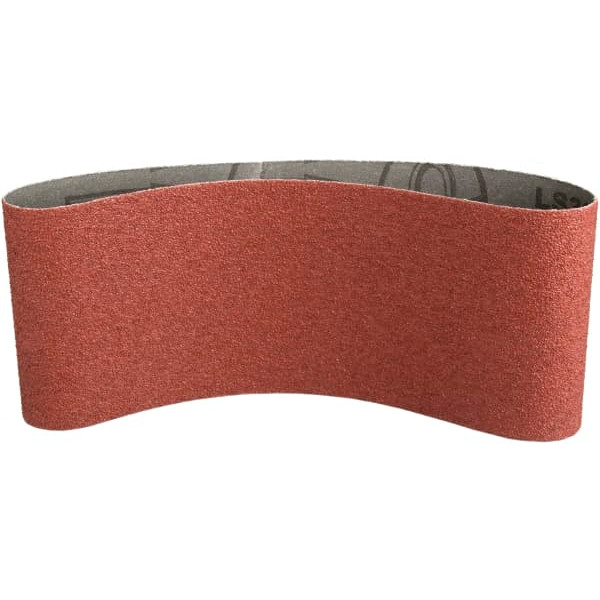Benefits:
- Special type for portable belt sanders
- For universal use on wood, metal, paint and varnish
- Large availability of sizes for all standard machines
Characteristics
Wide range of applications
We carry a comprehensive range of abrasive belts - from the smallest file belt for hand-operated machines to wide belts for large grinding machines. All products we make originate in our own production facilities where we complete all manufacturing steps from making the basic product to finishing the ready-to-use belt.
Specialised products
We engineer the combinations of our synthetically produced grit types including aluminium oxide, silicon carbide, zirconia alumina and ceramic aluminium oxide, of our backings made of paper, cotton cloth, non-woven polyester web and blended fabric and of our basic bond for the power transmission between grit and backing specifically to the requirements of each material.
Unfailing availability
The bulk of our abrasive belts is available from stock. Belts that we do not carry in stock are available on short notice as well. What is more, our production facilities are capable of manufacturing custom products that include special belt joints and belt edges and are suitable for special applications and machinery.
Grit Size
The grit size indicates the abrasive grade on the abrasive side of the paper. A higher grit number indicates a smaller abrasive grain and a finer abrasive product. A “P” in front of the grit size indicates that the product is graded in accordance with the European FEPA standard (www.fepa-abrasives.org).
Indication of use
The terms coarse, medium and fine are often used in conjunction with grit size of abrasive grains. What grits sizes are located within the individual terms?
| 12,16,20 | super coarse | For extra deep and coarse cutting, e.g. floor sanding. |
| 24,30,36 | extra coarse | For coarse cutting. |
| 40,50,60 | coarse | For cutting and sanding uneven surfaces. |
| 80,100 | medium | For sanding marks and uneveness. |
| 120,150,180 | fine | For fine-sanding, and use between and after final surface treatment. |
| 220,240,280,320 | extra fine | For final sanding where there is a particular requirement for a smooth surface. |
| 400,500,600 | super fine | For final sanding where there is a particular requirement for an extra smooth surface. |
| 800, 1200 and finer | ultra fine | For final sanding where there is a particular requirement for and extremely smooth surface. |
Grit size tips
Grit sizes above 240 are defined as extra fine and used mostly on special hard, fine surfaces that require special considerations taken to the surface.
Hard woods are harder to grind than soft. Go up a grit size to avoid scratches you would have to spend extra time to sand away again.
Look for products with a P in front of the grit size. These have a uniform size of grains in its scale related to the FEPA P strandard. This ensures a smooth sanding.
Choose quality products - so you avoid irregularities in the paper that can damage the substrate.
How closely a product is coated - i.e. how many sand grains there are per m2 varies. Typically 50 to 75% of the surface is covered with grain. The coarse grit sizes are usually scattered more open than the finer. A densely littered product immediately gives a good performance at startup. A more open coat can give a better effect over time. This is because dust tends to adhere to the surface and this happens a lot faster with products that have a dense coat.
Belt joints for long and short belts
Klingspor supplies belts with various types of joints. The type of joint you require depends on the work involved and the machine you are using. The following illustrations show the usual types of joint.
The available types of joint are listed in the product charts on the following product pages.
If the product you require is not in stock, we will manufacture it for you subject to a minimum order quantity.
Type 1
Diagonal cut, glued overlapped.
Type 2
Diagonal cut, glued overlapped. Grain tips are completely removed from the overlap to provide for a smoother running belt
Type 3 G
Zig zag joint, with cloth-reinforced foil backing, impact-free working at very sensitive parts, in particular glass.
Type 4 G
Diagonal cut. Butt joint with cloth-
reinforced foil backing. Also suitable for working on unsupported belts, for demanding requirements.
Type 5
Overlapping glued joint. Grit zone is completely ground off. Preferred joint for wood finishes with flat contact elements
Type 6 G
Diagonal cut, butt joint with cloth-
reinforced foil glued on grit side. Grit zone is completely ground off. Use on machines with planar contact elements.
Type 7 G
Sine joint, with cloth-reinforced foil backing, impact-free working at very sensitive parts, for demanding requirements.
Type 3 W/4 W
Special belt joint for non-woven web belts. Tape reinforced butt joint with additional frontal adhesion.





